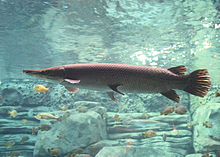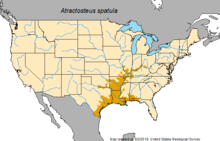
Back التمساح غار Arabic التمساح غار ARZ Missisipi zirehlisi Azerbaijani Мисисипски зарган Bulgarian Atractosteus spatula Catalan Atractosteus spatula CEB Kostlín obrovský Czech Alligatorhecht German Atractosteus spatula Spanish Atractosteus spatula Basque
| Alligator gar Temporal range: [1]
| |
|---|---|

| |
| Alligator gar in an aquarium | |
| Scientific classification | |
| Domain: | Eukaryota |
| Kingdom: | Animalia |
| Phylum: | Chordata |
| Class: | Actinopterygii |
| Clade: | Ginglymodi |
| Order: | Lepisosteiformes |
| Family: | Lepisosteidae |
| Genus: | Atractosteus |
| Species: | A. spatula
|
| Binomial name | |
| Atractosteus spatula (Lacépède, 1803)
| |

| |
| Synonyms[3] | |
|
Species
| |
The alligator gar (Atractosteus spatula) is a euryhaline ray-finned fish in the clade Ginglymodi of the infraclass Holostei /hoʊˈlɒstiaɪ/, being most closely related to the bowfins. It is the largest species in the gar family (Lepisosteidae), and is among the largest freshwater fish in North America. The fossil record traces its group's existence back to the Early Cretaceous over 100 million years ago. Gars are often referred to as "primitive fishes" or "living fossils", because they have retained some morphological characteristics of their early ancestors, such as a spiral valve intestine, which is also common to the digestive system of sharks, and the ability to breathe in both air and water. Their common name was derived from their resemblance to the American alligator, particularly their broad snouts and long, sharp teeth. It is suggested that an alligator gar can grow up to 10 ft (3.0 m) in length.
The body of an alligator gar is torpedo-shaped, usually brown or olive colored, fading to a lighter gray or yellow ventral surface. In very rare occurrences, they can also be black, seen in gars that have a high level of melanin. Their scales are not like the scales of other fishes; rather, they are ganoid scales, which are bone-like, rhomboidal-shaped scales, often with serrated edges, and covered by an enamel-like substance. Ganoid scales are nearly impenetrable, and are excellent protection against predation. Unlike other gar species, the upper jaw of an alligator gar has a dual row of large, sharp teeth that are used to impale and hold prey. Alligator gar are stalking, ambush predators, primarily piscivores, but they also ambush and eat waterfowl and small mammals they find floating on the water's surface.
Populations of alligator gar have been extirpated from much of their historic range as a result of habitat destruction, indiscriminate culling, and unrestricted harvests. Populations are now located primarily in the southern portions of the United States extending into Mexico. They are considered euryhaline because they can adapt to varying salinities, ranging from freshwater lakes and swamps to brackish marshes, estuaries, and bays along the Gulf of Mexico.
For nearly a half century, alligator gar were considered "trash fish",[4] or a "nuisance species" detrimental to sport fisheries, and were targeted for elimination by state and federal authorities in the United States. The 1980s brought a better understanding of the ecological balance necessary to sustain an ecosystem,[5] and an awareness that the alligator gar is an important element of the ecosystems they inhabit was eventually understood.[6] Over time, alligator gar were afforded some protection by state and federal resource agencies. They are also protected under the Lacey Act, which makes transporting certain species of fish in interstate commerce illegal when in violation of state law or regulation. Several state and federal resource agencies are monitoring populations in the wild, and have initiated outreach programs to educate the public. Alligator gar are being cultured in ponds, pools, raceways, and tanks by federal hatcheries for mitigation stocking, by universities for research purposes, and in Mexico for consumption.[7]
- ^ "Atractosteus spatula (Bernard Germain de Lacépède)". Paleontological database.
- ^ Collette, B.B.; Grubbs, D.; Pezold, F.; Simons, J.; Caruso, J.; Carlson, J.; McEachran, J.D.; Brenner, J.; Tornabene, L.; Chakrabarty, P.; Robertson, R.; Daniels, A.; Maiz-Tome, L.; Lyons, T.J. (2019). "Atractosteus spatula". IUCN Red List of Threatened Species. 2019: e.T191024A1966892. doi:10.2305/IUCN.UK.2019-2.RLTS.T191024A1966892.en. Retrieved June 11, 2022.
- ^ Froese, R.; Pauly, D. (2017). "Lepisosteidae". FishBase version (02/2017). Retrieved May 18, 2017.
- ^ Brady, Tony (August 2013). "Fleur De Lis Fisheries" (PDF). US Fish & Wildlife Service. p. 2.
- ^ Milbrath, Lester W. (1989). Envisioning a Sustainable Society: Learning Our Way Out. SUNY Press. p. 271. ISBN 9780791401620.
- ^ Echevarria, Carlos (February 5, 2013). "Alligator Gar, Atractosteus spatula". Warm Springs National Fish Hatchery. US Fish & Wildlife Service. Retrieved July 7, 2014.
- ^ Lochmann, S.E.; Baker, Brandon W.; Rachels, Kyle T.; Timmons, Brett A. "New Research". Aquaculture and Fisheries Center. University of Arkansas at Pine Bluff. Archived from the original on July 14, 2014. Retrieved June 18, 2014.
© MMXXIII Rich X Search. We shall prevail. All rights reserved. Rich X Search
